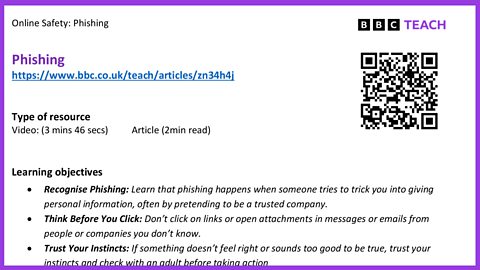This video was produced in partnership with Childnet for Safer Internet Day 2025, which is based around the theme: Too good to be true? Protecting yourself and others from scams online. Find free supporting resources to use alongside the video on the UK Safer Internet Centre website. See a British Sign Language version of the video below on this page.
Safer Internet Day 2025 – Live Lesson
Join us at 11:00 on Tuesday, 11 February to help spot the scams in this interactive Live Lesson.
Fishing?
No, not that kind.
I mean, fishing with a p h.
It happens when someone tries to trick you into giving out your personal details online, like passwords or bank information, by pretending to be someone they're not.
The internet offers amazing ways to communicate and learn and play games, but there are some websites and people online that can't be trusted.
Phishing messages often look like they're from a trusted company or person, but there are clues like strange links or requests for personal information that should make you stop and think.
I'm going to show you how…
Imagine you're fishing. You need some bait. Maybe something fish like to eat, like worms or sweet corn. The bait is there to tempt fish in, but once they bite, they're caught.
Fishing online is just like that. You might receive fake emails or messages that might look like they're from your favourite game, someone you know, or even your school. But they're not. Just like how the fish think, the bait is real food. You might think these messages are real, but there's a hidden hook behind them.
These messages try to trick you into clicking a link, or maybe giving up personal information like your password or address.
The good news is, just like how we can spot the bait on the hook, we can also learn to spot phishing attempts online. If something feels strange, like a message asking for your personal details, it could be trying to trick you. Always stop and think before you click.
Remember, if you're unsure, ask a trusted adult to help. Don't let the scammers catch you with their sneaky hooks.
If I can just finish this English homework, I can finally play my new Battle Legends game.
Alert! Immediate action was quiet. Oh, no. That's from Battle Legends. Your account has been stolen. Click here to change your password. Now.
What? My account's been hacked. I'll lose all my game progress. Wait a second. They're asking for my password. That's weird. I don't remember them ever asking for that before. I'm going to go to the official website.
There's now a lot about my account here. And their official email doesn't have symbols like this weird one. Who writes like that? Well, you could get me one of your little games that you fake battle legends. Well, I'm telling mum.
Ah, yes! The official Battle Legends announcement. So excited.
So here are the things to remember. Phishing is when someone online tries to trick you into giving personal information, often by pretending to be a trusted company. Don't click on links or open attachments in messages or emails from people or companies. You don't know if something feels not right or sounds too good to be true. Trust your instincts and check with an adult.
That's it. Done. Does it smell a fish in here?
Video summary
Emma-Louise Amanshia introduces the topic of phishing, explaining that it is when someone tries to trick you into giving out your personal details online, like passwords or bank information. The analogy of fishing is used to explain how phishing works, emphasising that some people online pretend to be an official company to hook us in with fake bait so that they can get personal information from us. A short dramatisation shows a young person receiving an email which looks like it is from their favourite online gaming platform. The email is trying to convince them that their account has been stolen and that they need to change their password.
Watch this film with British Sign Language
Fishing?
No, not that kind.
I mean, fishing with a p h.
It happens when someone tries to trick you into giving out your personal details online, like passwords or bank information, by pretending to be someone they're not.
The internet offers amazing ways to communicate and learn and play games, but there are some websites and people online that can't be trusted.
Phishing messages often look like they're from a trusted company or person, but there are clues like strange links or requests for personal information that should make you stop and think.
I'm going to show you how…
Imagine you're fishing. You need some bait. Maybe something fish like to eat, like worms or sweet corn. The bait is there to tempt fish in, but once they bite, they're caught.
Fishing online is just like that. You might receive fake emails or messages that might look like they're from your favourite game, someone you know, or even your school. But they're not. Just like how the fish think, the bait is real food. You might think these messages are real, but there's a hidden hook behind them.
These messages try to trick you into clicking a link, or maybe giving up personal information like your password or address.
The good news is, just like how we can spot the bait on the hook, we can also learn to spot phishing attempts online. If something feels strange, like a message asking for your personal details, it could be trying to trick you. Always stop and think before you click.
Remember, if you're unsure, ask a trusted adult to help. Don't let the scammers catch you with their sneaky hooks.
If I can just finish this English homework, I can finally play my new Battle Legends game.
Alert! Immediate action was quiet. Oh, no. That's from Battle Legends. Your account has been stolen. Click here to change your password. Now.
What? My account's been hacked. I'll lose all my game progress. Wait a second. They're asking for my password. That's weird. I don't remember them ever asking for that before. I'm going to go to the official website.
There's now a lot about my account here. And their official email doesn't have symbols like this weird one. Who writes like that? Well, you could get me one of your little games that you fake battle legends. Well, I'm telling mum.
Ah, yes! The official Battle Legends announcement. So excited.
So here are the things to remember. Phishing is when someone online tries to trick you into giving personal information, often by pretending to be a trusted company. Don't click on links or open attachments in messages or emails from people or companies. You don't know if something feels not right or sounds too good to be true. Trust your instincts and check with an adult.
That's it. Done. Does it smell a fish in here?
Video: 3min 46sec
Learning objectives
- Recognise Phishing: Learn that phishing happens when someone tries to trick you into giving personal information, often by pretending to be a trusted company.
- Think Before You Click: Don’t click on links or open attachments in messages or emails from people or companies you don’t know.
- Trust Your Instincts: If something doesn’t feel right or sounds too good to be true, trust your instincts and check with an adult before taking action.
Glossary
- Phishing: emails or other types of messages online pretending to be someone they’re not and trying to get your personal information.
- Personal information: details about yourself that tells someone exactly who you are, such as your real name, date of birth, address, phone number, etc.
- Fake messages: a message online that isn’t truly from the person it says it is from.
- Scam: when someone tries to trick us into giving them personal information or money.
- Hacking: when someone uses a computer or other type of technology to access data and information.
Topic introductions and starters
Before the video:
- Do you know what online phishing is?
- If you do, what examples of phishing are there?
- How might phishing try to trick us into giving our personal information away?
- How might someone feel if they are tricked by phishing?
- What should you do if you think you’ve seen phishing?
- What should you do if you think you’ve been tricked by phishing?
After the video:
- What does the first email that the character receives say?
- What is it telling the character to do?
- How does the email nearly persuade the character to change their password?
- Why does the character begin to feel suspicious and unsure about the email?
- What does the character do to check if the email is trustworthy?
- What else does the character notice about the email that makes them feel suspicious and unsure?
- What does the character decide to do when they realise that the email is fake?
Activities
- Write and design a pretend example of phishing, then swap your example with your partner. How is your partner’s example trying to trick you into giving your personal information?
- Create a mind map of the different types of phishing someone your age needs to look out for when they are online.
- Create a top tips poster, advising other young people about how to keep themselves safe from phishing.
More from: Online safety
How to manage your online self-image and identity video
Introduces the topic of self image and identity online, giving examples of how someone might express themselves.
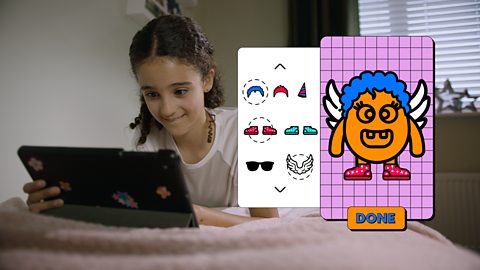
What are online relationships? video
Explains the different types of relationships we might have online, and some of the risks involved when talking to people online we don’t know.
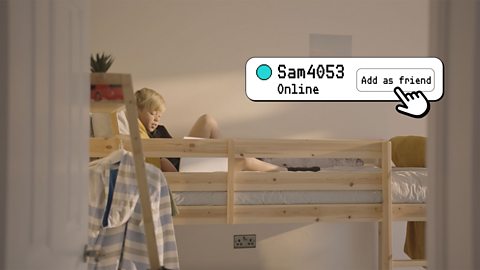
What is online reputation? video
Explains how the things we do online create a digital footprint, and the possible positives and negatives involved when leaving this footprint.
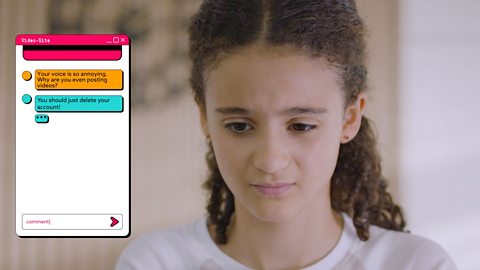
What is online bullying? video
Introduces the topic of online bullying and what this could look like, as well as giving some ideas of what to do if you encounter it.
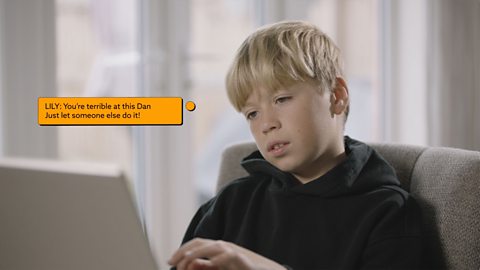
How to find reliable information online. video
An introduction to the topic of managing online information – discussing the positives and negatives.
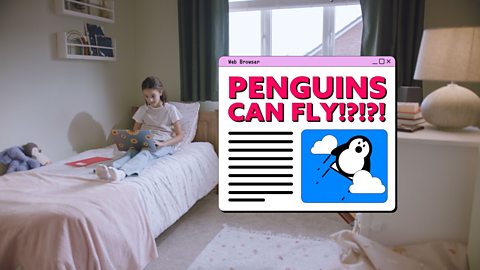
How to balance your screen time – health and wellbeing online. video
Explains that going online can have positive and negative impacts, so we need to balance our time online and offline.
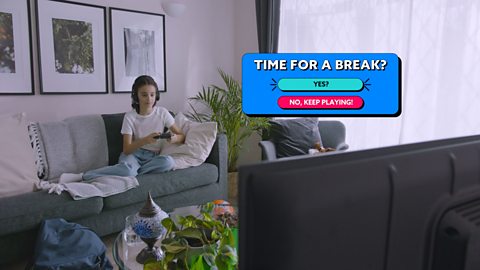
How to keep your information safe online video
Introduces the topic of privacy and security, explaining that personal information shouldn’t be shared online and that passwords should be strong.

What is copyright and ownership? document
Introduces the topic of 'copyright and ownership', explaining that the creative content that people post online belongs to them.
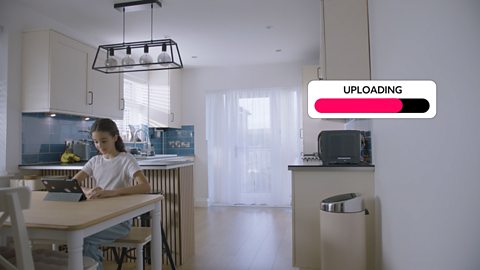
Scams: Safer Internet Day resources for 7-11-year-olds. video
Introduces the topic of scams, explaining that people online sometimes try to trick us into giving them personal information or money.

